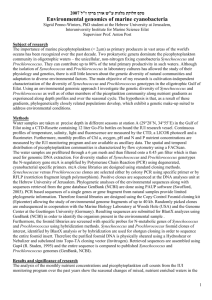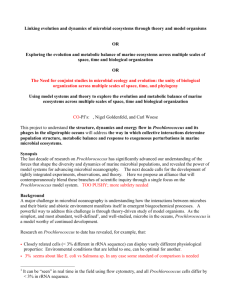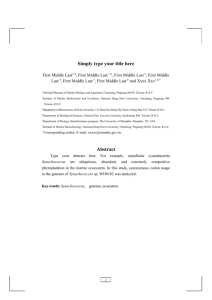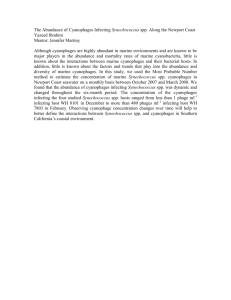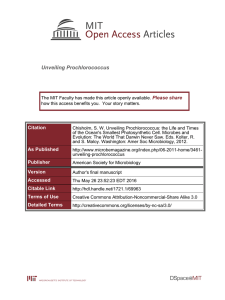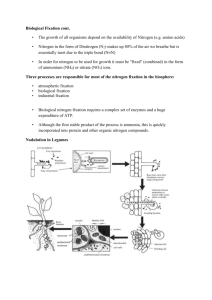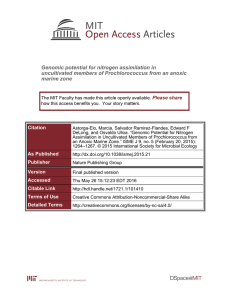Supplementary Information (doc 1161K)
advertisement
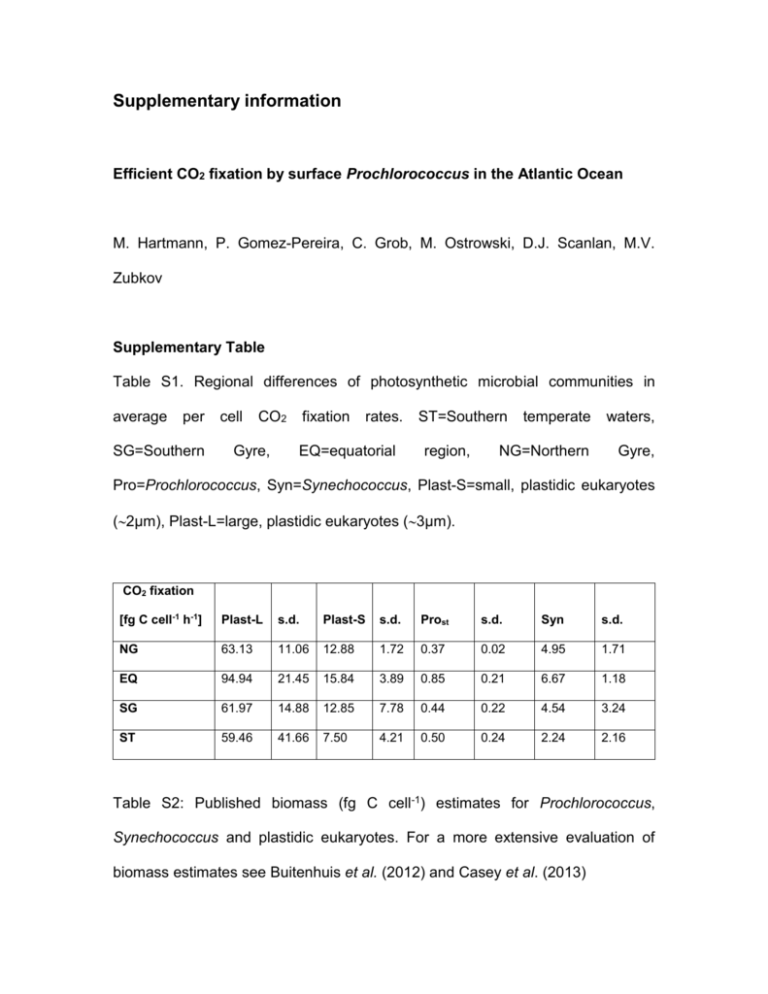
Supplementary information Efficient CO2 fixation by surface Prochlorococcus in the Atlantic Ocean M. Hartmann, P. Gomez-Pereira, C. Grob, M. Ostrowski, D.J. Scanlan, M.V. Zubkov Supplementary Table Table S1. Regional differences of photosynthetic microbial communities in average per SG=Southern cell CO2 Gyre, fixation rates. EQ=equatorial ST=Southern region, temperate waters, NG=Northern Gyre, Pro=Prochlorococcus, Syn=Synechococcus, Plast-S=small, plastidic eukaryotes (2µm), Plast-L=large, plastidic eukaryotes (3µm). CO2 fixation [fg C cell-1 h-1] Plast-L s.d. Plast-S s.d. Prost s.d. Syn s.d. NG 63.13 11.06 12.88 1.72 0.37 0.02 4.95 1.71 EQ 94.94 21.45 15.84 3.89 0.85 0.21 6.67 1.18 SG 61.97 14.88 12.85 7.78 0.44 0.22 4.54 3.24 ST 59.46 41.66 7.50 4.21 0.50 0.24 2.24 2.16 Table S2: Published biomass (fg C cell-1) estimates for Prochlorococcus, Synechococcus and plastidic eukaryotes. For a more extensive evaluation of biomass estimates see Buitenhuis et al. (2012) and Casey et al. (2013) Pro s.d. Syn s.d. Euk 3800 59 250 53 246 49 92 32 29 27 s.d. Reference Biomass based on 100 Verity et al. (1992) cultures literature estimates carbon conversion cell diameter literature estimates carbon conversion cell diameter Li et al. (1992) 2108 Campbell et al. (1994) 800, 1360 Montagnes et al. (1994) Cailliau et al. (1996) Veldhuis et al. (1997) Zubkov et al. (1998) Liu et al. (1999) Zubkov et al. (2000) Claustre et al. (2002) Llewellyn and Gibb (2000) DuRand et al. (2001) Heldal et al. (2003) Bertilsson et al. (2003) Worden et al. (2004) Fu et al. (2007) Grob et al. (2007) 9 175 10 350 100 6 4400 56 30 53 39 16 29 6.873 52 16b and 26a 41 112 9 1 1 11 19 0.9b and 2.2 a 21 170 82 249 60 4694 250 65 8 21 19 91 2587 99 32 163 92 530 185 730 226 for and for and cultures cultures cultures natural population cultures natural population cultures cultures cultures cultures cultures cultures cultures natural population Grob et al. (2013) natural population 554 Casey et al. (2013) natural population 1031* 112 This pub natural population 2359 1572 Average * weighted average of Plast-S and Plast-L a Pro unst b Pro st Table S3: Comparison of published group-specific CO2 fixation rates (fg C cell-1 h-1) in surface Atlantic waters. Pro=Prochlorococcus, Syn=Synechococcus, PlastS=small, plastidic eukaryotes (2µm), Plast-L=large, plastidic eukaryotes (3µm), NE=Northeast Atlantic, NG=Northern Gyre EQ=equatorial region, SG=Southern Gyre. Pro s.d. 0.81 Syn s.d. Plast-S s.d. Plast-L s.d. 7.68 193.16 Region Reference NE 1.2 0.6 9.5 4.3 54.3 19 230.1 86.1 NE 0.37 0.85 0.44 0.50 0.02 0.21 0.22 0.24 4.95 6.67 4.54 2.24 1.71 1.18 3.24 2.16 12.88 15.84 12.85 7.50 1.72 3.89 7.78 4.21 63.13 94.94 61.97 59.46 11.06 21.45 14.88 41.66 NG EQ SG ST Li, 1994 Jardillier et al. 2010 This study This study This study This study Supplementary Figures: Fig. S1. Flow cytometry data scatter plots of samples taken at station 74 in the South Atlantic subtropical gyre indicating Prost (a and c) and Prounst (b and d) populations at 20 m depth (a and b) and 85 m depth (c and d). No significant changes can be observed in stained samples (a and c) while there is a significant increase in red autofluorescence (FL3) observable in unstained samples (b and d). Synechococcus cyanobacteria (Syn) are indicated in unstained samples (b and d) for comparison. Fig. S2. Cruise track on AMT-20 in 2010. Stations were CO2 fixation measurements were carried out as well as regional boundaries are indicated. Black filled circles represent stations were CO2 fixation at 20m was determined, nutrient addition experiments are indicated by green filled circles and blue filled circles highlight stations were in addition to 20m CO2 fixation was also measured for a deeper sample at the bottom of the thermocline. NG=Northern Gyre, EQ=Equatorial region, SG=Southern Gyre, ST=Southern temperate waters. Fig. S3. Total CO2 fixation: (a) Selection of time series measurements proving linear 14C uptake during the observed time course (white and black filled circles represent dark controls, i.e. CO2 fixation in the absence of light), (b) Comparison of total CO2 fixation measured by filtering small volumes (1-3ml) or large volumes (300ml) showing comparable uptake rates in the gyre region indicating that by sampling small volumes the whole community can be captured. Fig. S4. Abundance of different microbial organisms at the beginning (T0) and after 10 h incubation (T10) during 14C uptake experiments. Pro=Prochlorococcus, Syn=Synechococcus, Plast-S=small, plastidic eukaryotes (2µm), Plast-L=large, plastidic eukaryotes (3µm), Bpl=total bacterioplankton including heterotrophic bacteria. Fig. S5. Comparison of 90° side light scatter geometrical means of Prounst populations before and after concentration of samples on 0.6 µm polycarbonate filter to show that SSC, indicative of cell size, remains unchanged by the procedure. The equation and R2 of the data’s linear regression line are presented in the graph. NG=Northern Gyre, EQ=Equatorial region, SG=Southern Gyre, ST=Southern temperate waters. Fig S6. Detailed per cell CO2 fixation rates for the different microbial groups in the low latitude Atlantic Ocean. ST=Southern temperate waters, SG=Southern Gyre, EQ=equatorial region, NG=Northern Gyre, Pro=Prochlorococcus, Syn=Synechococcus, Plast-S=small, plastidic eukaryotes (2µm), Plast-L=large, plastidic eukaryotes (3µm). Supplementary Fig. 1 Supplementary Fig. 2 Supplementary Fig. 3 Supplementary Fig. 4 Supplementary Fig. 5 Supplementary Fig. 6 Supplementary References Bertilsson S, Berglund O, Karl DM, Chisholm SW (2003). Elemental composition of marine Prochlorococcus and Synechococcus: Implications for the ecological stoichiometry of the sea. Limnol. Oceanogr. 48: 1721-1731. Buitenhuis ET, Li WKW, Vaulot D, Lomas MW, Landry MR, Partensky F et al (2012). Picophytoplankton biomass distribution in the global ocean. Earth Syst. Sci. Data 4: 37-46. Cailliau C, Claustre H, Vidussi F, Marie D, Vaulot D (1996). Carbon biomass, and gross growth rates as estimated from C-14 pigment labelling, during photoacclimation in Prochlorococcus CCMP 1378. Mar. Ecol. Prog. Ser. 145: 209-221. Campbell L, Nolla HA, Vaulot D (1994). The importance of Prochlorococcus to community structure in the central North Pacific Ocean. Limnol. Oceanogr. 39: 954-961. Casey JR, Aucan JP, Goldberg SR, Lomas MW (2013). Changes in partitioning of carbon amongst photosynthetic pico- and nano-plankton groups in the Sargasso Sea in response to changes in the North Atlantic Oscillation. Deep-Sea Research Part Ii-Topical Studies in Oceanography 93: 58-70. Claustre H, Bricaud A, Babin M, Bruyant F, Guillou L, Le Gall F et al (2002). Diel variations in Prochlorococcus optical properties. Limnol. Oceanogr. 47: 16371647. DuRand MD, Olson RJ, Chisholm SW (2001). Phytoplankton population dynamics at the Bermuda Atlantic Time-series station in the Sargasso Sea. Deep-Sea Research Part Ii-Topical Studies in Oceanography 48: 1983-2003. Fu FX, Warner ME, Zhang YH, Feng YY, Hutchins DA (2007). Effects of increased temperature and CO2 on photosynthesis, growth, and elemental ratios in marine Synechococcus and Prochlorococcus (Cyanobacteria). J. Phycol. 43: 485-496. Grob C, Ostrowski M, Holland RJ, Heldal M, Norland S, Erichsen ES et al (2013). Elemental composition of natural populations of key microbial groups in Atlantic waters. Environ. Microbiol. 15: 3054-3064. Grob C, Ulloa O, Claustre H, Huot Y, Alarcon G, Marie D (2007). Contribution of picoplankton to the total particulate organic carbon concentration in the eastern South Pacific. Biogeosciences 4: 837-852. Heldal M, Scanlan DJ, Norland S, Thingstad F, Mann NH (2003). Elemental composition of single cells of various strains of marine Prochlorococcus and Synechococcus using X-ray microanalysis. Limnol. Oceanogr. 48: 1732-1743. Li WKW, Dickie PM, Irwin BD, Wood AM (1992). Biomass of bacteria, cyanobacteria, prochlorophytes and photosynthetic eukaryotes in the Sargasso Sea. Deep-Sea Research Part a-Oceanographic Research Papers 39: 501-519. Liu HB, Bidigare RR, Laws E, Landry MR, Campbell L (1999). Cell cycle and physiological characteristics of Synechococcus (WH7803) in chemostat culture. Mar. Ecol. Prog. Ser. 189: 17-25. Llewellyn CA, Gibb SW (2000). Intra-class variability in the carbon, pigment and biomineral content of prymnesiophytes and diatoms. Mar. Ecol. Prog. Ser. 193: 33-44. Montagnes DJS, Berges JA, Harrison PJ, Taylor FJR (1994). Estimating carbon, nitrogen, protein, and chlorophyll-a from volume in marine phytoplankton. Limnol. Oceanogr. 39: 1044-1060. Veldhuis MJW, Kraay GW, VanBleijswijk JDL, Baars MA (1997). Seasonal and spatial variability in phytoplankton biomass, productivity and growth in the northwestern Indian Ocean: The southwest and northeast monsoon, 1992-1993. Deep-Sea Research Part I-Oceanographic Research Papers 44: 425-449. Verity PG, Robertson CY, Tronzo CR, Andrews MG, Nelson JR, Sieracki ME (1992). Relationships between cell-volume and the carbon and nitrogen content of marin photosynthetic nanoplankton. Limnol. Oceanogr. 37: 1434-1446. Worden AZ, Nolan JK, Palenik B (2004). Assessing the dynamics and ecology of marine picophytoplankton: The importance of the eukaryotic component. Limnol. Oceanogr. 49: 168-179. Zubkov MV, Sleigh MA, Burkill PH, Leakey RJG (2000). Picoplankton community structure on the Atlantic Meridional Transect: a comparison between seasons. Prog. Oceanogr. 45: 369-386. Zubkov MV, Sleigh MA, Tarran GA, Burkill PH, Leakey RJG (1998). Picoplanktonic community structure on an Atlantic transect from 50°N to 50°S. Deep Sea Res. I (Oceanogr. Res. Pap.) 45: 1339-1355.
